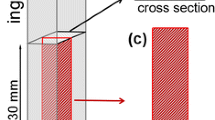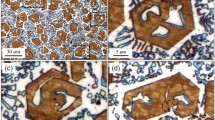Abstract
The microstructure and the phase composition of a heat-resistant Fe–Cr–Ni alloy (0. 45C–25Cr–35Ni) has been investigated in the cast state and after annealing at 1150°C for 2–100 h. After a 2-h high-temperature annealing, the fragmentation of the crystal structure of the eutectic M 7C3 carbides into domains of ~500 nm in size with a partial transition into M 23C6 carbides is observed. After a 100-h holding, the complete transition of the hexagonal M 7C3 carbides into M 23C6 with a face-centered cubic structure occurs. The carbide transition M 7C3 →M 23 can be considered to be an in situ transformation.
Similar content being viewed by others
References
M. Garbiak, W. Jasinski, and B. Piekarski, “Materials for reformer furnace tubes. History of evolution,” Arch. Foundry Eng. 11, 47–52 (2011).
M. N. Ilman, “Analysis of material degradation and life assessment of 25Cr–38Ni–Mo–Ti wrought alloy steel (HPM) for cracking tubes in an ethylene plant,” Eng. Fail. Anal. 42, 100–108 (2014).
D. J. Tillack and J. E. Guthrie, “Wrought and cast heatresistant stainless steels and nickel alloys for the refining and petrochemical industries,” in Nickel Development Institute, Toronto: Technical Series, No. 10, 71–85 (1998).
B. Piekarski, “Improving the resistance to carburising of creep-resistant castings,” Arch. Foundry Eng. 8, 181–184 (2008).
A. A. Kaya, P. Krauklis, and D. J. Young, “Microstructure of HK40 alloy after high-temperature service in oxidizing/ carburizing environment: I. Oxidation phenomena and propagation of a crack,” Mater. Char. 49 (1), 11–21 (2002).
A. A. Kaya, “Microstructure of HK40 alloy after hightemperature service in oxidizing/carburizing environment: II. Carburization and carbide transformations,” Mater. Char. 49 (1), 23–34 (2002).
Y. Jingbo, G. Yimin, Y. Fang, Y. Caiying, Y. Zhaozhong, Y. Dawei, and M. Shengqiang, “Effect of tungsten on the microstructure evolution and mechanical properties of yttrium modified HP40Nb alloy,” Mater. Sci. Eng., A 529, 361–369 (2011).
G. F. van der Voort, G. M. Lucas, and E. P. Manilova, “Metallography and microstructures of heat-resistant alloys,” in ASM Handbook, vol. 9: Metallography and Microstructures, Ed. by G. F. van der Voort (ASM International, Metals Park, Ohio, 2004), pp. 820–859.
E. A. Kenik, P. J. Maziasz, R. W. Swindeman, J. Cervenka, and D. May, “Structure and phase stability in cast modified-HP austenite after long-term ageing,” Scr. Mater. 49, 117–122 (2003).
F. C. Nunes, L. H. de Almeida, J. Dille, J.-L. Deldlancke, and I. le May, “Microstructural changes caused by yttrium addition to NbTi-modified centrifugally cast HP-type stainless steels,” Mater. Char. 58, 132–142 (2007).
V. A. Barinov, A. V. Protasov, and V. T. Surikov, “Studying mechanosynthesized Hägg carbide (Fe5C2),” Phys. Met. Metallogr. 116, 791–801 (2015).
A. I. Rudskoy, A. S. Oryshchenko, S. Yu. Kondrat’ev, G. P. Anastasiadi, M. D. Fuks, and S. N. Petrov, “Special features of structure and long-term strength of cast refractory alloy 45Kh26N33S2B2,” Met. Sci. Heat Treat. 55, 209–215 (2013).
A. I. Rudskoi, G. P. Anastasiadi, S. Yu. Kondrat’ev, A. S. Oryshchenko, and M. D. Fuks, “Effect of electron factor (number of electron holes) on kinetics of nucleation, growth, and dissolution of phases during long-term high–temperature holdings of 0.45C–26Cr–33Ni–2Si–2Nb superalloy,” Phys. Met. Metallogr. 115, 1–11 (2014).
A. I. Rudskoy, A. S. Oryshchenko, S. Yu. Kondrat’ev, G. P. Anastasiadi, and M. D. Fuks, “Mechanisms and kinetics of phase transformations in refractory alloy 45Kh26N33S2B2 in long-term high-temperature holds. Part 1,” Met. Sci. Heat Treat. 56, 3–8 (2014).
A. I. Rudskoy, S. Yu. Kondrat’ev, G. P. Anastasiadi, A. S. Oryshchenko, M. D. Fuks, “Mechanisms and kinetics of phase transformations in refractory alloy 45Kh26N33S2B2 in long-term high-temperature holds. Part 1,” Met. Sci. Heat Treat. 56, 124–130 (2014).
L. G. Korshunov, V. V. Sagaradze, N. L. Chernenko, and V. A. Shabashov, “Friction-induced structural transformations of the carbide phase in Hadfield steel,” Phys. Met. Metallogr. 116, 823–828 (2015).
K. G. Buchanan and M. V. Kral, “Crystallography and morphology of niobium carbide in as-cast HP-niobium reformer tubes,” Metall. Mater. Trans. A 43, 1760–1769 (2012).
T. Sourmail, “Precipitates in creep resistant austenitic stainless steels,” Mater. Sci. Technol. 17, 1–14 (2001).
I. I. Gorbachev, A. Yu. Pasynkov, and V. V. Popov, “Prediction of the austenite-grain size of microalloyed steels based on the simulation of the evolution of carbonitride precipitates,” Phys. Met. Metallogr. 116, 1127–1134 (2015).
I. A. Sustaita-Torres, S. Haro-Rodrigues, M. P. Guerrero-Mata, M. de la Garza, E. Valdes, F. Deschaux- Beaume, and R. Colas, “Aging of cast 35Cr–45Ni heat resistant alloy,” Mater. Chem. Phys. 133, 1018–1023 (2012).
S. Yu. Kondrat’ev, A. V. Ptashnik, G. P. Anastasiadi, and S. N. Petrov, “Analysis of transformations of carbide phases in alloy 25Cr35Ni by the method of quantitative electron microscopy,” Met. Sci. Heat Treat. 57, 402–409 (2015).
A. I. Rudskoi, S. Yu. Kondrat’ev, G. P. Anastasiadi, A. S. Oryshchenko, M. D. Fuks, and S. N. Petrov, “Transformation of the structure of refractory alloy 0.45C–26Cr–33Ni–2S–2Nb during a long-term high-temperature hold,” Met. Sci. Heat Treat. 55, 517–525 (2014).
K. Yamamoto, M. Hashimoto, N. Sasaguri, and Y. Matsubara, “Solidification of high chromium cast iron substituted by 25 to 70 mas. % Ni for Fe,” Mater. Trans. 50, 2253–2258 (2009).
Author information
Authors and Affiliations
Corresponding author
Additional information
Original Russian Text © V.S. Kraposhin, S.Yu. Kondrat’ev, A.L. Talis, G.P. Anastasiadi, 2017, published in Fizika Metallov i Metallovedenie, 2017, Vol. 118, No. 3, pp. 240–246.
Rights and permissions
About this article
Cite this article
Kraposhin, V.S., Kondrat’ev, S.Y., Talis, A.L. et al. Experimental investigation of in-situ transformations of the M 7C3 carbide in the cast Fe–Cr–Ni alloy. Phys. Metals Metallogr. 118, 227–232 (2017). https://doi.org/10.1134/S0031918X17030085
Received:
Revised:
Published:
Issue Date:
DOI: https://doi.org/10.1134/S0031918X17030085




